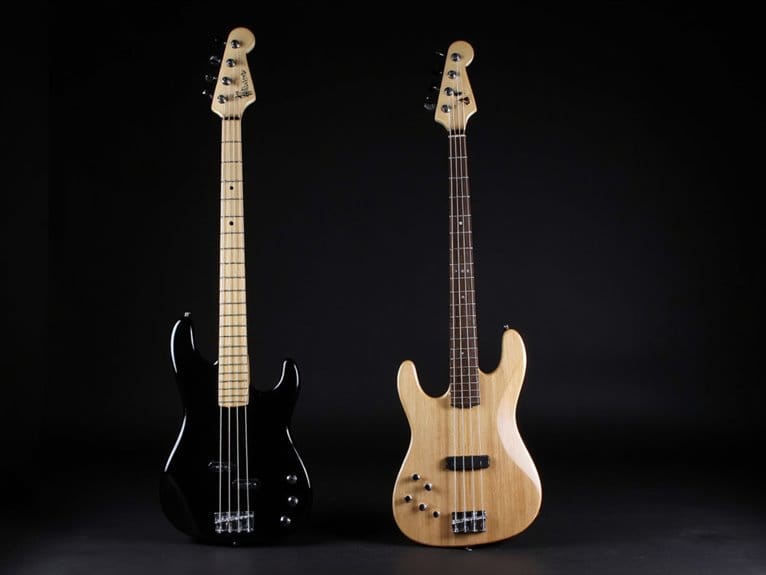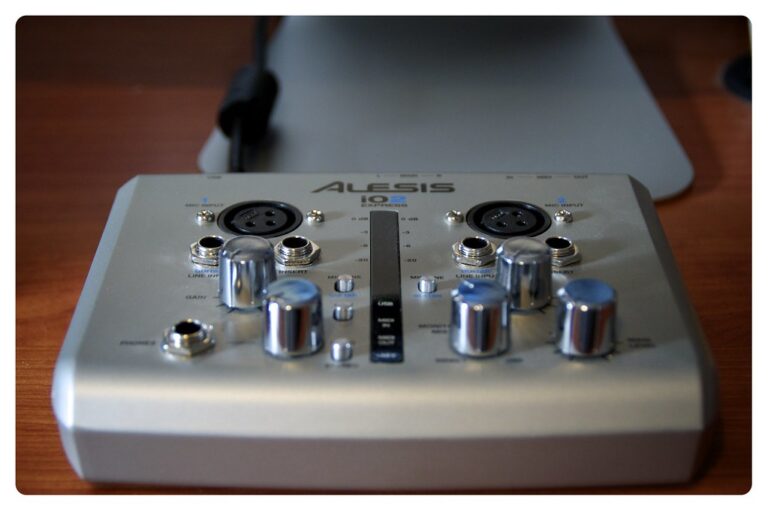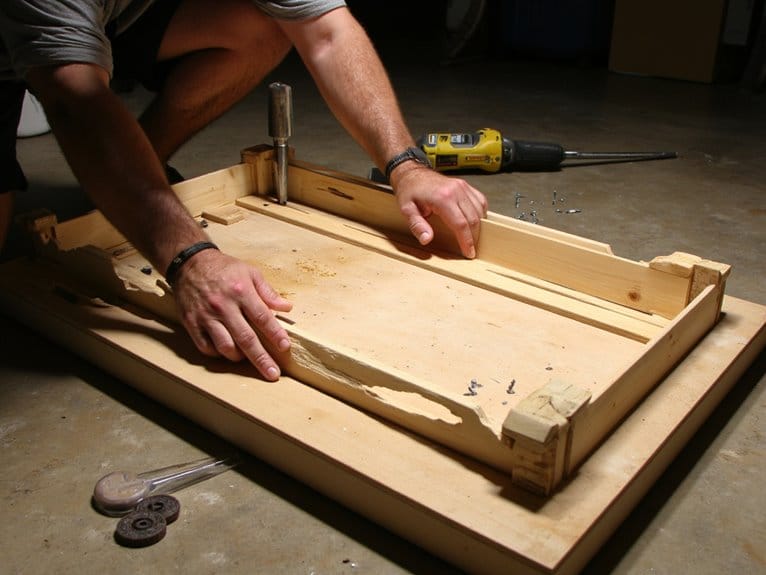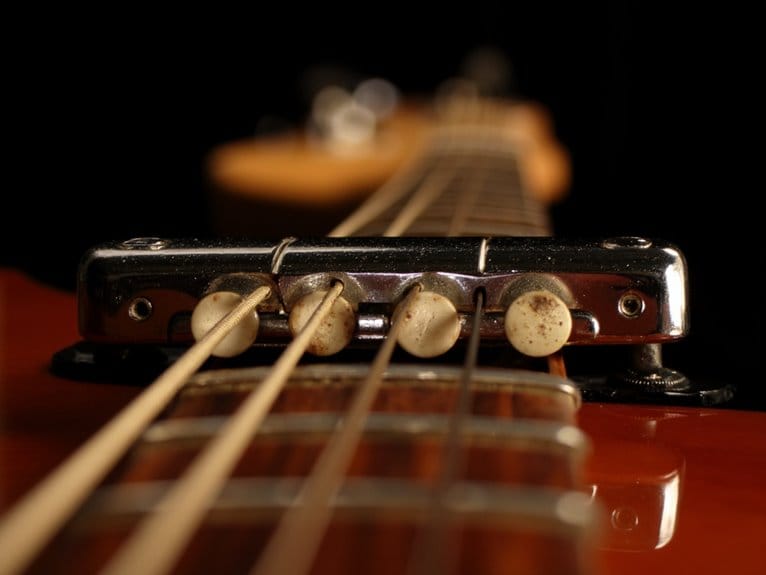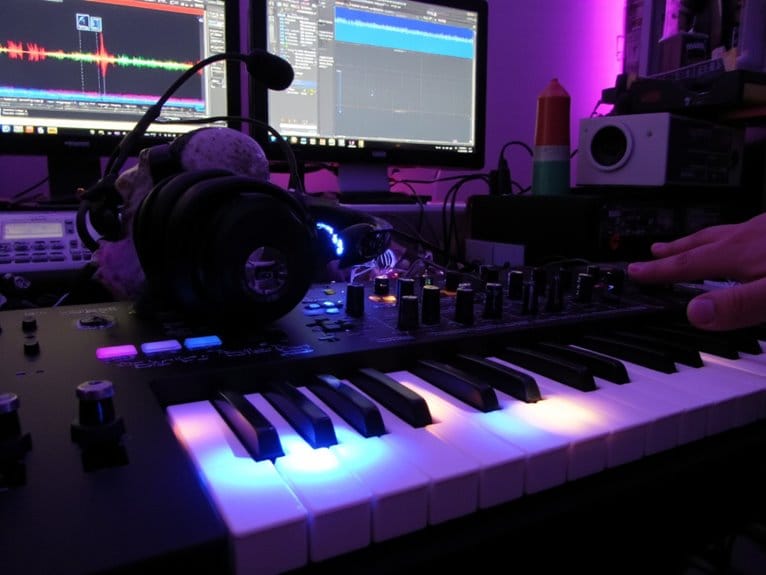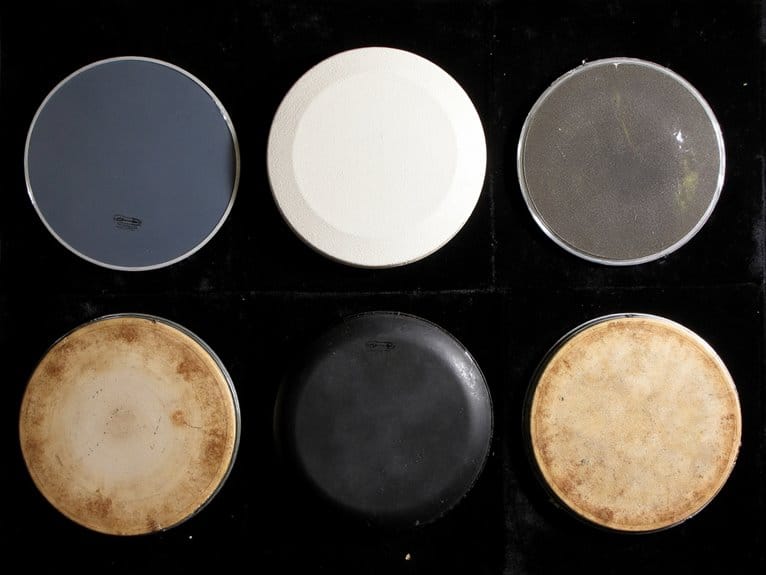Fretted Vs Fretless Bass: Pros and Cons
You’ll find fretted bass offers precise intonation and aggressive attack perfect for rock and funk, while fretless delivers expressive microtonal capabilities with that signature “mwah” sound favored in jazz fusion. Fretted models cost less, require minimal maintenance, and provide easier learning curves for beginners. Fretless instruments demand steeper learning curves, frequent fingerboard conditioning, and higher prices, but reward you with unmatched expressiveness and smooth note shifts that’ll expand your creative horizons considerably.
We are supported by our audience. When you purchase through links on our site, we may earn an affiliate commission, at no extra cost for you. Learn more.
Notable Insights
- Fretless bass offers expressive sliding tones and microtonal adjustments but requires precise finger placement and ear training.
- Fretted bass provides immediate note accuracy and clarity, making it easier for beginners with consistent attack and sustain.
- Fretless instruments need frequent fingerboard conditioning and refinishing, costing $200-400 more in long-term maintenance than fretted basses.
- Fretted models are generally less expensive and more widely available due to simpler construction and mass production economics.
- Fretless excels in jazz fusion and melodic genres, while fretted bass dominates rock, pop, and funk applications.
Sound Quality and Tonal Differences
When I first picked up a fretless bass after years of playing fretted instruments, the tonal differences hit me immediately—it’s like comparing a paintbrush to a pencil, where one offers precise lines and the other allows for fluid, expressive strokes.
Your fretted bass delivers exceptional sound clarity with distinct note separation, making it perfect for rock and funk where definition matters most.
However, fretless instruments provide superior tonal richness through microtonal adjustments and that characteristic “mwah” quality that resembles upright basses.
While fretted designs give you consistent attacks and metallic brightness from the frets themselves, fretless basses offer warmer, more organic tones with smoother shifts between notes, though they require considerably more precision from your finger placement. The reduced finger pressure needed on fretless instruments also helps minimize fatigue during extended playing sessions.
Fretted basses provide more attack and sustain thanks to the consistent contact points from the metal frets, which creates that percussive quality essential for driving rhythmic sections.
Learning Curve and Skill Requirements
Although I’ve taught countless students over the years, I can’t sugarcoat the reality that fretless bass presents a noticeably steeper learning curve than its fretted counterpart. It requires you to develop precise finger placement through ear training alone rather than relying on physical fret markers.
Fretless bass demands genuine ear training and precise finger placement—there’s no shortcut around this steeper learning curve.
The fretless challenges you’ll face include constant pitch monitoring, muscle memory development, and exhausting early practice sessions where your ear works overtime. Meanwhile, fretted advantages shine through immediate note accuracy, clearer articulation for techniques like hammer-ons, and faster technical achievements that keep you motivated.
The fretted bass features metal strips that subdivide the fingerboard into definite pitches, making note identification significantly easier for developing players. Many players also rely on high-quality single coil pickups to achieve crystal clear tone and versatility when amplifying their bass guitar.
Emotional realities you’ll encounter:
- Frustration from countless out-of-tune notes during early fretless practice
- Pride when your ear finally develops superior intonation skills
- Exhaustion from continuous pitch correction and finger pressure adjustment
- Confidence gained through fretted bass’s forgiving physical boundaries
- Accomplishment when mastering fretless expression unavailable on fretted instruments
Maintenance Requirements and Long-Term Durability
When you’re weighing the long-term ownership costs between fretted and fretless basses, you’ll discover that the presence or absence of metal frets creates dramatically different maintenance demands, wear patterns, and financial commitments over your instrument’s lifespan.
Your fretted bass benefits from built-in protection since those metal barriers shield the fingerboard from direct contact damage, while your fretless bass faces accelerated wood wear that requires more frequent conditioning, potential refinishing, and careful environmental management to prevent costly repairs.
I’ve learned through years of maintaining both types that understanding these maintenance realities upfront, including how fret protection translates to lower long-term costs versus the higher but manageable upkeep of exposed wood surfaces, helps you make informed decisions about which bass style fits your budget and commitment level.
Budget-friendly instruments often use quality fingerboards like rosewood that provide good durability for either fretted or fretless configurations, making them viable options for players considering long-term maintenance costs. The body weight and balance of your instrument between 8 to 11 pounds also impacts long-term comfort and reduces physical strain during extended maintenance sessions.
Similar to how bass drum pedals require varying maintenance with double chain systems needing more attention than single chain models, your choice between fretted and fretless bass will determine the maintenance frequency and complexity you’ll face throughout ownership.
Fingerboard Wear Patterns
Since I’ve owned both fretted and fretless basses for over two decades, I can tell you that fingerboard wear patterns reveal one of the most significant practical differences between these instruments.
On fretted basses, metal frets protect the fingerboard wood, creating minimal wear between fret positions while distributing string pressure effectively across the metal barriers.
However, fretless fingerboards endure direct string contact, developing distinctive grooves along string paths where you press most frequently, particularly under common playing positions that see heavy use during performances and practice sessions.
Just as high-quality instrument cables feature durable jacket materials to protect against wear in demanding performance environments, choosing the right fingerboard material becomes crucial for managing long-term durability. Quality materials like Canadian maple and mahogany provide enhanced durability that helps resist the inevitable wear patterns that develop from regular playing.
Proper initial setup adjustments of your bass guitar can significantly minimize fingerboard wear by optimizing string action and reducing unnecessary pressure during playing.
The emotional reality of fingerboard wear:
- Watching your favorite fretless develop permanent string grooves
- Discovering expensive refinishing costs after years of neglecting maintenance
- Feeling frustrated when worn fingerboards affect your playing technique
- Experiencing relief when fingerboard material selection prevents premature damage
- Implementing effective wear prevention techniques to preserve your investment
Fret Protection Benefits
While fretless basses demand constant vigilance against fingerboard wear, fretted instruments offer you a significant maintenance advantage through their built-in metal barriers, though they’ll still require proper protection techniques during routine upkeep procedures.
| Protection Method | Key Advantage |
|---|---|
| Stainless Steel Shields | Prevent scratches during fret leveling |
| Reusable Guards | Eliminate tape masking costs |
| Professional Sets | Maintain resale value |
The fret protection benefits extend beyond simple scratch prevention, as quality shields preserve your instrument’s wood integrity while streamlining maintenance workflows. These tools enhance maintenance efficiency by reducing prep time and encouraging more frequent care, since you’ll worry less about accidental damage. I’ve found that investing in proper fret guards pays dividends through reduced repair costs and extended fretboard life, particularly when using power tools or aggressive polishing compounds during setup work. Many budget bass guitars experience inconsistent neck quality issues upon arrival, making proper maintenance tools even more crucial for optimal playability. Just as transparent overdrive pedals preserve your amp’s natural character while adding subtle enhancement, proper fret protection maintains your bass’s original tone and playability while enabling necessary maintenance procedures. Additionally, maintaining your bass’s electrical components through quality preamp pedals can significantly enhance your instrument’s tonal flexibility and overall sound quality during both practice sessions and live performances.
Maintenance Cost Comparison
Beyond the initial purchase price, the long-term financial commitment between fretted and fretless basses reveals a clear cost disparity that every player should understand before making their choice.
Fretted basses typically maintain lower upkeep costs since metal frets protect the fingerboard from direct string contact, reducing maintenance frequency markedly. Conversely, fretless instruments demand more expensive, specialized care—fingerboard resurfacing, conditioning treatments, and precision setups that require skilled technicians familiar with their unique requirements.
Your wallet will feel these differences:
- Fingerboard refinishing costs can reach $200-400 for fretless basses
- Setup fees run higher due to precision requirements
- Specialized maintenance products add ongoing expense
- Custom work commands premium pricing
- Environmental damage repairs become costly necessities
Cost Considerations and Market Availability
When you’re shopping for your next bass, you’ll quickly notice that fretted models typically cost markedly less than their fretless counterparts, primarily because manufacturers can produce them more efficiently and in higher volumes.
The price gap becomes even more apparent in entry-level instruments, where budget-friendly fretted basses flood the market while affordable fretless options remain frustratingly scarce.
Beyond initial purchase price, you’ll also encounter stark differences in where and how easily you can find these instruments, as fretted basses dominate both physical stores and online marketplaces while fretless models often require hunting through specialty retailers or custom builders.
Price Differences Explained
Three key factors drive the price differences between fretted and fretless basses, and I’ll be honest—the disparity might surprise you if you’re shopping for your first instrument.
Construction complexity considerably impacts cost, as fretless fingerboards require precision craftsmanship and higher-grade materials to withstand string wear without protective frets.
Market dynamics favor fretted instruments through economies of scale, while fretless models often come from smaller production runs, limiting discount opportunities across various price ranges.
Manufacturing differences create these disparities:
- Fretless fingerboards demand specialized smooth finishing processes that increase labor costs
- Premium woods and exotic materials are standard in fretless construction
- Custom boutique builders charge premiums for limited-run fretless instruments
- Entry-level fretless options remain scarce, forcing buyers toward mid-tier pricing
- Ongoing maintenance expenses favor fretted basses through simpler, cheaper repairs
Market Availability Factors
Although price ultimately influences your purchasing decision, finding a fretless bass to actually buy presents its own unique challenges that I’ve witnessed frustrate countless players over the years.
Fretless basses represent merely 3% of the total market, creating significant distribution challenges that limit your options dramatically. While fretted basses enjoy extensive availability through major retail chains and music stores, you’ll likely find yourself searching specialized dealers or online platforms for fretless models.
Market trends consistently favor fretted instruments, encouraging retailers to optimize inventory turnover by stocking what sells fastest. This creates a frustrating cycle where limited availability reduces exposure, which further dampens consumer interest and perpetuates scarcity in physical stores nationwide.
Genre Compatibility and Musical Applications
Different musical genres showcase dramatically different preferences for fretted versus fretless bass, and I’ve noticed that understanding these patterns can considerably influence your instrument choice and playing approach.
Jazz fusion and progressive genres heavily favor fretless instruments for their expressive sliding tones and microtonal capabilities, while rock and metal overwhelmingly prefer fretted basses for aggressive attack and precise intonation. Your genre preferences will largely dictate which instrument serves you best, though musical versatility often benefits from understanding both approaches.
- Jazz legends like Jaco Pastorius transformed fretless bass into an expressive voice that speaks directly to your soul.
- Progressive metal players use fretless instruments to create haunting, melancholy atmospheres that give you chills.
- Funk musicians embrace fretless bass for its warm, vocal-like qualities that make you feel the groove.
- Classical traditions depend on fretless double bass for its natural acoustic resonance that moves you emotionally.
- Pop and disco genres typically avoid fretless instruments, potentially limiting your mainstream commercial opportunities.
Playing Techniques and Creative Expression
When you pick up a fretless bass, the fundamental approach to playing technique shifts dramatically from what you’ve learned on fretted instruments, demanding a completely different relationship between your fretting hand, your ear, and the fingerboard itself. While your right hand techniques translate seamlessly between both instruments, your left hand must develop surgical precision to avoid intonation disasters that’ll make you cringe.
| Technique Aspect | Fretted Bass | Fretless Bass |
|---|---|---|
| Note Separation | Distinct, consistent stops | Requires manual control |
| Slide Expression | Limited by fret boundaries | Unlimited glissando potential |
| Vibrato Control | Mechanically guided | Completely manual execution |
The expressive nuances available on fretless create vocal-like phrasing impossible on fretted instruments, though you’ll need advanced technical skills to harness this creative freedom without accidentally wandering into pitch limbo.
Choosing the Right Bass for Your Musical Goals
With all this technical knowledge about playing techniques rattling around in your head, you’re probably wondering which bass will actually serve your musical ambitions without driving you crazy in the process.
The answer hinges on aligning your instrument choice with your specific musical goals, considering both musical versatility and personal preference as primary factors.
If you’re gravitating toward rock, pop, or funk, a fretted bass delivers the defined attack and rhythmic precision these genres demand.
However, if jazz fusion or expressive melodic lines appeal to you, fretless offers unmatched tonal flexibility and microtonal capabilities that’ll expand your creative palette considerably.
Fretless basses require precise finger placement and technique for optimal performance, making them more challenging for beginners but ultimately more rewarding for expressive playing.
For those just starting their bass journey, beginner-friendly options between $130-$200 provide solid construction and sound quality suitable for learning fundamental techniques before advancing to more specialized instruments. Pickup configuration significantly affects your tonal versatility and sound quality, with humbucking pickups providing thicker, warmer sounds suitable for heavier rock styles.
- Fretted basses excel in high-energy live performances requiring consistent intonation
- Fretless instruments reward patient practice with extraordinary expressive range
- Genre conventions often dictate which bass type sounds most authentic
- Your current skill level impacts how quickly you’ll achieve satisfying results
- Long-term versatility considerations affect your instrument’s adaptability across different musical projects
Frequently Asked Questions
Can You Convert a Fretted Bass to Fretless by Removing the Frets?
You can convert your fretted bass to fretless using proper fret removal techniques like specialized pullers, then filling slots with wood putty. This allows sound difference exploration, though it’s labor-intensive and affects resale value permanently.
How Does String Choice Differ Between Fretted and Fretless Bass Guitars?
You’ll find string materials create significant tone differences between fretted and fretless basses. Fretted basses typically use roundwounds for brightness, while fretless basses often employ flatwounds or tapewounds for warmer, smoother sounds.
On a final note
Whether you’re drawn to the precision and reliability of frets or the expressive freedom of a fretless fingerboard, your choice ultimately depends on your musical priorities, technical aspirations, and stylistic preferences. You can’t go wrong with either option if you’ve honestly assessed your skill level, budget constraints, and genre requirements. Trust your instincts, consider your long-term goals, and remember that many accomplished bassists eventually own both instruments for different musical contexts.

